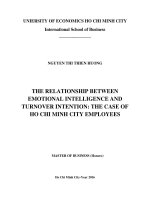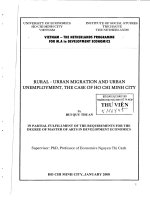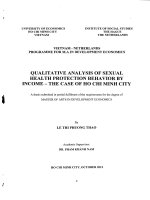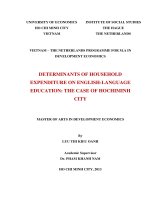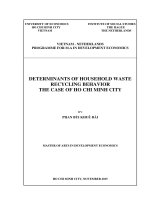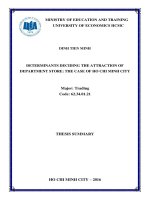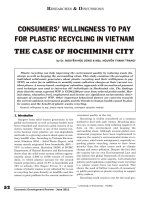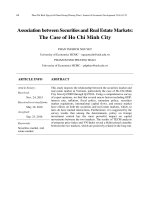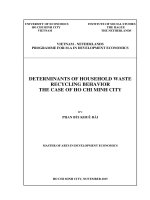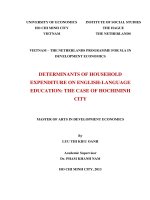The relationship between emotional intelligence and turnover intention the case of ho chi minh city employees
Bạn đang xem bản rút gọn của tài liệu. Xem và tải ngay bản đầy đủ của tài liệu tại đây (1.41 MB, 81 trang )
UNIERSITY OF ECONOMICS HO CHI MINH CITY
International School of Business
------------------------------
NGUYEN THI THIEN HUONG
THE RELATIONSHIP BETWEEN
EMOTIONAL INTELLIGENCE AND
TURNOVER INTENTION: THE CASE OF
HO CHI MINH CITY EMPLOYEES
MASTER OF BUSINESS (Honors)
Ho Chi Minh City-Year 2016
UNIERSITY OF ECONOMICS HO CHI MINH CITY
International School of Business
------------------------------
NGUYEN THI THIEN HUONG
THE RELATIONSHIP BETWEEN
EMOTIONAL INTELLIGENCE AND
TURNOVER INTENTION: THE CASE OF
HO CHI MINH CITY EMPLOYEES
ID: 22130029
MASTER OF BUSINESS (Honors)
SUPERVISOR: DINH THAI HOANG
Ho Chi Minh City-Year 2016
ACKNOWLEDGEMENT
First all, I would like to express my sincere gratitude to my supervisor, Dr Dinh Thai
Hoang, for his professional guidance, positive encouragements and helpful guidance during the
time of doing my research.
I would like to express my appreciation to Dr. Nguyen Dong Phong, Dr. Nguyen Dinh
Tho, Dr. Tran Ha Minh Quan and Dr. Nguyen Thi Nguyet Que for their valuable time and advice
as the members of the proposal examination committee. Their comments and meaningful
suggestions are significantly contributed to this research completion.
My sincere thanks are given to all of my teachers at International Business School for
their teaching and guidance during my master course.
Finally, my deepest gratitude also goes to my family for their financial support and gentle
encouragement so that I have an opportunity to be here - University of Economics of Ho Chi
Minh City.
ABSTRACT
The concept of employee turnover intention is becoming a popular topic for managerial
effectiveness both in the public organization and private companies. In 21st century, employee
retention is considered as a key factor for business survival for all level of management in
service industry. However, very few of the scholars have discussed about this matter particularly
in the field of sales. In term of sales management, staff turnover is also incredibly important due
to the nature of sales positions, their historically high turnover levels, and the difficulty involved
in filling them. In an effort to help sales executive have an overview about the behavior and
performance of employees, the present study explores the relationship between emotional
intelligence and turnover intention through the impact of emotional intelligence on work-family
conflict and emotional exhaustion. A survey had sample size of 201 valid questionnaires that
were used for data analysis with CFA and SEM. The findings broaden knowledge on how these
variables affect the turnover intention and how to reduce turnover rate more successfully in the
world of intense competition.
Keywords: Emotional intelligence, work-family conflict, emotional exhaustion, turnover
intention, turnover.
CONTENTS
ACKNOWLEDGEMENT
ABSTRACT
ABBREVIATION
Chapter 1: INTRODUCTION ....................................................................................................................... 1
1.1
Background to the research and research problem ........................................................................... 1
1.2
Research objectives ........................................................................................................................... 4
1.3
Methodology ..................................................................................................................................... 5
1.4
Research significance........................................................................................................................ 5
1.5
Research structure ............................................................................................................................. 6
CHAPTER 2 LIETERATURE REVIEW AND HYPOTHESES ................................................................. 7
2.1
Turnover intention ............................................................................................................................ 7
2.2
Emotional intelligence ...................................................................................................................... 8
2.3
Work-family conflict......................................................................................................................... 9
2.4
Emotional exhaustion...................................................................................................................... 11
2.5
Relationship among variables ......................................................................................................... 11
2.6
Conceptual model ........................................................................................................................... 15
Chapter 3: METHODOLOGY ................................................................................................................... 17
3.1
Research design .............................................................................................................................. 17
3.1.1
Research process ..................................................................................................................... 17
3.1.2
Measurement scales ................................................................................................................ 19
3.2
The quantitative study ..................................................................................................................... 23
3.2.1
Sampling and data collection .................................................................................................. 23
3.2.2
Data analysis procedure .......................................................................................................... 24
Chapter 4: DATA ANALYSIS ................................................................................................................... 26
4.1
Respondents’ demographics ........................................................................................................... 26
4.2.1
CFA for the first-order constructs ........................................................................................... 28
4.2.2
CFA for second-order constructs ............................................................................................ 32
4.2.3
CFA for the final measurement model .................................................................................... 34
4.3 Structural equation modeling (SEM) .................................................................................................... 39
4.4
Discussion ....................................................................................................................................... 42
Chapter 5: CONCLUSIONS, IMPLICATIONS AND LIMITATION ....................................................... 46
5.1
Conclusions and implications ......................................................................................................... 46
5.2
Limitations and recommendations for Future Research ................................................................. 49
REFERENCES ........................................................................................................................................... 51
APPENDIX ................................................................................................................................................. 60
LIST OF FIGURES
Figure 2.1 Conceptual model ...................................................................................................................... 15
Figure 3.1 Research process ....................................................................................................................... 18
Figure 4.1 CFA model of Work-Family Conflict ....................................................................................... 28
Figure 4.2 CFA model of emotional exhaustion ......................................................................................... 30
Figure 4.3 CFA model of turnover intention .............................................................................................. 30
Figure 4.4 CFA model of Emotional Intelligence....................................................................................... 33
Figure 4.5 Final measurement model .......................................................................................................... 38
Figure 4.6 Structural results (standardized estimates) ................................................................................ 40
LIST OF TABLES
Table 3.1 Source of data collection............................................................................................................. 23
Table 4.1 Respondents’ characteristics ....................................................................................................... 27
Table 4.2 The first run of CFA (of work-family conflict, emotional exhaustion and turnover intention) .. 29
Table 4.3 Summarized of CR, AVE and Cronbach’α (first order constructs) ............................................ 31
Table 4.4 Summarized of CR, AVE andCronbach’α (emotional intelligence)........................................... 32
Table 4.5 Correlation (of Emotional Intelligence) ...................................................................................... 34
Table 4.6 Summarized of CR, AVE and Cronbach’α (final model) ........................................................... 35
Table 4.7 CFA Summary of eliminated item .............................................................................................. 36
Table 4.8 Correlations (final measurement model)..................................................................................... 36
Table 4.9 Chi-square difference test for the constrained and unconstrained models (other-emotions
appraisal and use of emotions) .................................................................................................................... 37
Table 4.10 Unstandardized structural paths ................................................................................................ 39
Table 4.11 Measurement validation ............................................................................................................ 41
LIST OF APPENDIX
Appendix A List of in-depth interviews’ participants................................................................................. 60
Appendix B Qualitative in-depth interview ................................................................................................ 60
Appendix C Qualitative in-depth interview findings .................................................................................. 63
Appendix D Questionnaire (English Version) ............................................................................................ 67
Appendix E Questionnaire (Vietnamese Version) ...................................................................................... 70
Appendix F Correlations among components of emotional intelligence, work-family conflict, emotional
exhaustion and turnover intention ............................................................................................................... 73
ABBREVIATION
AVE
Averaged variance extracted
CFA
Confirmatory Factor Analysis
COR
Conservation of resource theory
CR
Composite reliability
EAPs
Employee Assistance Programs
EFA
Exploratory Factor Analysis
GDP
Gross Domestic Product
GSO
General Statistics Office of Vietnam
ILO
International Labor Organization
SEM
Structural equation modeling
SPSS
Statistical Package for the Social Sciences
Chapter 1: INTRODUCTION
1.1
Background to the research and research problem
In the recent decades, the concept of employee turnover intention has been further
becoming a popular term in various studies on different managerial disciplines; thus, prompting
more executives/managers in many different business fields (e.g. sales in service industry) to
apply this concept for their employee management (Tett & Meyer, 1993; Lee & Chon, 2000).
Lee and Chon (2000) identify job turnover intention as key considered management term for
successful careers and business survival at all level in service industry for 21st century.
Therefore, organizations in the service industry should give a try to improve their people worklife and take advantages of these emotional balance to create beneficial outcomes.
The special feature of a service industry is “the contact and interaction between service
providers (employees) and service acceptors (customers)” (Tsaur, Chang, & Wu, 2003, p. 435).
The main products provided by service organizations are services and the employees who play
role as service providers will provide those services to customers. Thus, employee in service
industry becomes a part of service products and the work-life balance will enhance their suitable
emotions in responding customers’ expectations help to form image of organizations (Kusluvan,
2003). The issue, then, is how service employees manage their emotions effectively and lessen
job turnover intention. Most successful service organizations understand their people’s feelings
and always have the special cares about any issues that may hurt the employees. Thus, the
traditional management provided by hierarchical structure might not be a truthful way to
understand subordinates while the tones of workloads and stresses are killing human emotions
even with the workaholic (Cropanzano, Rupp & Byrne, 2003). It is critical for an organizations
to build a working environment of trust, understanding and encouraging (Taylor, 2001).
1
In the trend of transitioning and developing Vietnam’s economy, service sector is
identified as one of the largest sectors in the economy and one of the biggest contributors to the
overall growth rate. According to the general statistics office of Vietnam, the growth rate of the
service industry is 6.56%/year and the economic structure has been adjusted to the better
direction that the services sector continued to contribute the largest portion to the GDP
increasing from 41.7% of 2012 to 43.31% in 2013. Furthermore, it is said that Service sector
plays a significant role in the economic development of Ho Chi Minh City with the fastest rate of
growth among industry and agriculture sectors during 2011-2013 (GSO, as cited in Tap Chi
Cong San, 2013). As a result, service domain should provide excellent customer service that
comes from a quality workforce. However, International Labor Organization (2015) stated that
Viet Nam’s labor productivity level is the lowest among ASEAN countries due to low-skill labor
forces and high job turn-over intention. This organization also assumes that recent productivity
growth rates are maintained, “Viet Nam will reach the Philippines only by 2038, Thailand by
2069 and take far more time to catch up with many other countries” (ILO, 2015, p. 1). It is also
said that Viet Nam's service workforce lacks experience, skills and professionalism for providing
good quality services (Tran, as cited in Xuan Huong, 2013). Aslam, Shumaila, Azhar and
Sadaqat (2011) realized that these service fields are experiencing labor shortage problems caused
by high job turnover and poor employee performance. Therefore, the service industry are
strongly required to improve its human resource management in providing services.
Currently, Vietnamese government efforts are trying to renovate service industry in
Vietnam. The workforce in this industry has been training to gain more experience, skills and
professionalism for providing good quality services (Nguyen Van Tuan, as cited in Thanh Tam,
2014). However, the challenge is that Vietnam service organizations are characterized by
2
hierarchical and autocratic styles which create a barrier preventing high management level to
understand the reason of high employee’s turnover intention. Numerous researchers have
emphasized the significant role of avoiding job turnover in organizations to remain competitive
in the rapidly expanding market and business survival (Knudsen, Ducharme & Roman, 2008;
Saeed, Waseem, Sikander, & Rizwan, 2014). Additionally, turnover intention is a painful issue
in human resources management which cause negative influence to the organizations including
cost of selection, recruitment, training, etc. (Lee & Chon, 2000; Saeed et al., 2014).
With the increasing interest in employee turnover intention, numerous studies have been
conducted in predictors of job turnover intention and they discovered several factors including
employee stress, job satisfaction and work-life balance. Among those, emotional intelligence is
also one of the key factor which affecting turnover intention (Avey, Luthans & Jensen, 2009).
Prior studies have confirmed that emotional intelligence strongly affects people intention to leave
their jobs in different managerial level by causing lack of trust, work–family conflict, and work
stress (O'Boyle, Humphrey, Pollack, Hawver & Story, 2011). Additionally, things change and
people change. People’s emotion changes quickly basing on the challenges in the workplaces.
Therefore, the management of employee emotional change is an issue for both employees and
organization in service industry.
Gabčanová (2011) stated that human resource is the most important asset of every
organization. It is neither that technology nor structure made the organization development but
people. The organization is evaluated as highest performance companies if they have high human
development index (Khan, Nazir, Kazmi, Khalid, Kiyani & Shahzad, 2014). Therefore, retaining
talented and knowledgeable employees become a major concern for many organizations. And
reducing employee turnover is one of real solutions for this issue (Aslam et al., 2011). As
3
employee turnover not only causes considerable financial costs to organizations but loses their
talents. Because of its powerful impact on both organization aspect and employee positive
emotion, many researches encourage to enhance managers’ acknowledgement about the
connection between emotional intelligence and turnover intention in order to retain its critical
workforce.
Up to now, numerous studies have been conducted about the perceptions of subordinates
in term of emotional intelligence, work-family conflict, emotional exhaustion, and employee
turnover intention and their significant mutual relationships in developed countries (O'Boyle et
al., 2011; Bande, Fernández-Ferrín, Varela & Jaramillo, 2015). Very few scholars do the
research about this issue in Vietnam where the term of emotional intelligence and turnover
intention are not truly considered in management. These studies, however, focus on other
contexts of turnover intention and these studies do not measure the relationships of these
concepts in one model (Tuan, 2013; Ninh, 2014). As indicated, however this issue has not yet
resolved. Thus, basing on this gap, this study aims for examining the mutual impact of emotional
intelligence on work-family conflict and emotional exhaustion, and subsequently exploring its
effect on turnover intention of sales employees in the service industry in Vietnam.
1.2
Research objectives
The overall objective of this study is to examine the role of emotional intelligence in
work-family conflict and emotional exhaustion, and subsequently in turnover intention of
salespeople who are working in the service industry in Ho Chi Minh City, Vietnam. Specifically,
it investigates:
4
1.3
The relationship between emotional intelligence and emotional exhaustion;
The relationship between emotional intelligence and work-family conflict;
The relationship between work-family conflict and emotional exhaustion;
The relationship between emotional exhaustion and turnover intention;
The relationship between work-family conflict and turnover intention.
Methodology
In this research, two phases of study were undertaken: a qualitative study and a
quantitative study. The questionnaire was translated from English into Vietnamese. Through
qualitative study, in-depth interviews with six people were conducted in order to adjust the items
closing to features of Vietnamese cultures and to make the improvement for the official
questionnaire. In the quantitative study, the author collected data by using a convenience
sampling approach and employed self-administered survey. For analyzing the collected data,
SPSS 16 and Amos 22 were used to test the model. For the reliability and validity, the researcher
used CFA. Then, SEM was used to test the hypothesized model.
Due to the limitation of time, this research is therefore limited to Vietnamese sales
employees who are working in service industry in Ho Chi Minh City; since it is one of the
biggest cities in Vietnam and most of service companies centralize here. Respondents of this
research include employees in sales departments.
1.4
Research significance
According to the managerial implications, this finding provides board of directors a deep
understanding about employee turnover intention that it significantly impact on organization’s
survival and development. Therefore, results of this study can be used to develop management
5
strategies to reduce the turnover rate and maximum performance and job satisfaction to retain
their valuable and experienced employees.
This study also contribute theory to the academic field. This is a unique study that
discover a relationship between emotional intelligence and turnover intention in the case of
Vietnamese employees. As a result, the sale and educational field is expected to expand the
literature.
1.5
Research structure
This thesis is organized into five chapters. The introduction chapter reflects the current
situation of service industry in Vietnam as well as discusses about the existing relationship of
emotional intelligence, work-family conflict, emotional exhaustion and employee turnover
intention in this field. It leads to propose the research problem, and research objectives. Besides
the significance of this thesis contributes to management practice, the scope of the research and
methodology of data analysis are also mentioned in the first chapter. The second chapter reviews
and synthesizes the theories in the literature of research’s concepts, including emotional
intelligence, work-family conflict, emotional exhaustion and turnover intention. Based on the
literature review, this chapter also presents the conceptual model and hypotheses. The third
chapter mentions about research methodology used to empirically test the research model.
Chapter four describes the results of data analysis and analyzes them for their relevance to the
research questions or hypotheses. The last chapter is organized to conclude about research
hypotheses, research problems. It also suggests implications for theories, implications for
policies and practices based on the findings; and points out some limitations for further research.
6
CHAPTER 2 LIETERATURE REVIEW AND HYPOTHESES
This chapter presents relevant literature about the research, which are conducted by many
scholar academic and are related to all research concepts and research model. Firstly, researcher
describes the concepts of emotional intelligence, work-family conflict, emotional exhaustion,
and turnover intention. Then, it reviews the previous research of these concepts and the related
discussion of the chosen subject. Finally, based on the foregoing review and previous research,
this section declares the hypotheses of this study.
2.1
Turnover intention
It has been established that employee turnover intention is one of strongest factor
projecting actual turnover (Knudsen et al., 2008). Turnover intention is defined when an
individual intents to leave their organization (Tett & Meyer, 1993; Khan et al., 2014). It is
inevitable that turnover occurs in every organization in which some of employees are voluntary
to leave the organization while others are discharged by organization. Either voluntary or
involuntary turnover creates serious consequences to organization in today’s business world
including a number of difficulties on replacement, recruitment, selection, socialization cost etc.
(Khan et al., 2014; Saeed et al., 2014). To be more detailed, there’s an unavoidable disruption in
productivity when an experienced employee leave the organization. Other employees have to
pull off their job to replace this position while the company finds quality candidates. When the
company does recruit a new employees, that person need to be trained weeks or months before
producing at the level of the former employee (Huselid, 1995).
According to Dess and Shaw (2001), turnover is divided into two types consisting of
voluntary turnover and involuntary turnover. It is called voluntary turnover when employees are
not satisfied with their job and willing to look for another job in another place. And turnover
7
intention is the volunteer intention of employees to have desire to leave their organization. On
the contract, it is called involuntary turnover when employees are fired by their organization.
High turnover rate is definitely not good for organization as it creases heavy cost in recruitment
for instance. However, the organization cannot reduce it to 0% as employee, who has poor
performance, need to be replaced with a qualified one which leads to the labor productivity
growth (Saeed et al., 2014). Thus, employee turnover not only has negative effects but also
positive effects to the organization (Staw, 1980).
Measuring actual employee turnover is one of the principal objectives that turnover
research is expected to reach, however, it is unable to be reached employee data. This data is not
correctly or consistently collected, so it is unavailable. Consequently, employee turnover
intention is used as a proxy for actual employee. As a result, one of the next best method to
measure actual turnover is turnover intention (Lambert, Hogan & Barton, 2001; Knudsen et al.,
2008). Employee turnover and turnover intention will be used interchangeably through this
study.
2.2
Emotional intelligence
Emotional intelligence is first identified as the concept of “social intelligence” to refer the
ability to use emotions in both oneself and others to produce beneficial outcomes (Thorndike,
1920, p.227). The definition given by Salovey and Mayer (1990) for emotional intelligence was
“the subset of social intelligence that involves the ability to monitor one’s own and others’
feelings and emotions, to discriminate among them and to use this information to one’s thinking
and actions” (p.189). With the increasing of interest on emotions, emotional intelligence has
received a substantial amount of attention among social and organizational psychologists. Mayer
and Salovey (1993) have established the scope of emotional intelligence consists of four
8
dimensions including (1) the self- emotions appraisal relating to the ability of a person to
understand own emotions and be able to express properly, then apply knowledge of those
emotions to create beneficial outcomes. Particularly, salesperson who have good emotions is
more likely good negotiation with customers and suppliers (Elfenbein, Der Foo, White, Tan &
Aik, 2007) and customers are the key area of most companies that can greater meet customer
satisfaction by increasing sales domain’s professionals (Martin, O'neill, Hubbard & Palmer,
2008); (2) the other emotions appraisal relating to the ability of an individual to observe and
understand other’s emotion. A person who have high capability in this dimension will have good
observe on other people’s emotions and predict other’s emotional reaction (Davies, Stankov &
Roberts, 1998); (3) the use of emotion relating to the ability of an individual to access, generate
and use his or her emotion to facilitate personal performance. People who rate highly in this
ability will able to return rapidly to normal psychological states after suffering depressed or
upset; (4) the regulation of emotion relating to the ability of a person to regulate his or her
emotion to achieve an expected outcome and able to remain balance from psychological distress
to solve problem (Mayer & Salovey, 1993; Wong & Law, 2002). Specific to sales section, a
salesperson with high ability in this area would performance effectively at enhancing customer
enthusiasm and reducing customer frustration (Kidwell, Hardesty, Murtha & Sheng, 2011).
Therefore, the need of understanding employee emotional intelligence is strongly considered in
this study.
2.3
Work-family conflict
The intersection of family care and paid work was the subject of innovative research
during the first decade of the 21st century and also continued to be a painful public policy issue
(Gao, Shi, Niu & Wang, 2013). Work-family conflict is defined as “a form of inter-role conflict
9
in which the role pressures from the work and family domains are mutually incompatible in
some respect” (Greenhaus & Beutell, 1985, p.76). Researchers have developed a variety of
conceptual frameworks to model the work-family conflict, Kelloway, Gottlieb and Barham
(1999) have divided work-family conflict into three types: time-based, strain-based and
behavior-based conflicts. Time-based conflict is experienced when the time demands for doing
one role restrict the amount of time that can be consumed to other role, interfering the
performance of the latter role. Strain based conflict takes place when pressure or strain from one
role affects performance of another role, and behavior-based conflict occurs when behavioral
patterns required and exhibited in one role are inconsistent with those expected for another role.
While others researchers define two types of conflict: work interfere with family and family
interfere with work (Boyar, Maertz Jr, Pearson, & Keough, 2003). This study considers one of
dimension of work-family conflict (work interfering to family), because researchers have argued
that work interfere with family is more common and closer associated with job satisfaction,
exhaustion and job turnover (Bande et al., 2015).
With this increasing interest in work-family conflict, numerous studies have been
conducted in the impact of work-family conflict on job and life satisfaction, increased job and
life stress, lowered organizational commitment, and increased intention to turnover (Boyar et al.,
2003; Allen & Armstrong, 2006). Work-family conflict arises in all kinds of job, however sales
positions have been proven that salesperson experience more negative effect from this conflict
than other position due to the nature of sales job. To be more detailed, work-family conflict
reduces level of job satisfaction in sales context more than other context (Boles, Dudley,
Onyemah & Rouzies, 2012). Although organization can be guilty for work-family conflict,
employees have an obligation for their work-life balance (Bande et al., 2015). Both organization
10
and its employee are responsible for eliminating work-family conflict (Hammonds, 1996;
Carmeli, 2003).
2.4
Emotional exhaustion
According to Moon and Hur (2011), emotional exhaustion is defined as the awareness
that emotional resource has been fully consumed. It is considered as the main dimension of three
dimensions in Maslach and Jackson’s (1981) classic model of employee burnout – (the three
dimensions
are
emotional
exhaustion,
depersonalization
and
diminished
personal
accomplishment) and emotional exhaustion is the core factor of job burnout (Jackson, Schwab &
Schuler, 1986). In this study, the author uses the words emotional exhaustion and burnout
interchangeably. The feelings of tiredness and fatigue, a lack of energy and the reduction of an
individual’s emotional resources are types of character of emotional exhaustion (Moore, 2000).
Emotional exhaustion is assumed to be the very first step of the burnout process (Gaines &
Jermier, 1983). Researchers have found that burnout leads to serious consequences for example
low quality of service and reductions of customer satisfaction, high level of job turnover and
absenteeism, poor job performance (Cropanzano et al., 2003) and poor morale (Grandey, 2003).
2.5
Relationship among variables
Emotional intelligence and work-family conflict are one of fundamental importance to
manufacture organizations (Lenaghan, Buda & Eisner, 2007). Both organization and its
employees are responsible for eliminating work-family conflict. Companies have their own
policies and procedures to help their staff manage stress, but their employees still burnt out.
Certainly, individuals hold some responsibility for regulating their own family balance, but they
need organizational support. Organizations need to recognize and adapt employees’ work and
lives to win employee loyalty (Keith, as cited in Carmeli, 2003).
11
According to the conservation of resource (COR) theory, Hobfoll, (1989) has identified
individual differences as resources causing the negative effects of stressful events on individuals.
Individuals who have more personal resources can deal with the loss of other kinds of resources,
including resource loss caused by work-family conflict. “Emotional intelligence represents
individual differences in the ability and capacity to monitor and recognize one’s own and other’s
emotions and to use this information to regulate one’s emotions and actions” (Gao et al., 2013,
p.223).
With respect to the role of individuals, researchers have emphasized emotional
intelligence is an important factor in protecting employees from the beginning of work-family
conflict and stress to identify, acknowledge and manage the emotions. Particularly, Suliman and
Al-Shaikh (2007) stated that in term of conflict management, employees with inflated level of
emotional intelligence seem to have effective control with conflict). Indeed, people with high
ability of emotional intelligence seem to suffer less work-family conflict (Lenaghan et al., 2007).
Accordingly, it is hypothesized that:
H1: Emotional intelligence has a negative impact on work-family conflict.
It has suggested that emotional intelligence enable individuals to control pressure and
adapt easily with the challenge to avoid the burnout (Bar-On, 1997; Taylor, 2001). In relation to
emotional exhaustion, people who have elevated levels of emotional intelligence dealing better
with life’s challenges and job stresses, which leads to good psychological and physical health
(Taylor, 2001) and makes them less likely to experience emotional exhaustion (Van Rooy &
Viswesvaran, 2004; Moon & Hur, 2011). The fourth dimension of emotional intelligence enables
a person to regulate their emotion quickly and work on emotive information effectively (Mayer
& Salovey, 1993; Wong & Law, 2002). Regarding to this matter, emotionally intelligent
12
individual helps salespeople choose appropriate approaches to cope with frustration and make a
response more effectively relating to the emotion aspect. Employees with high levels of
emotional intelligence can keep away from dysfunctional and angry emotions that would be
consequence on burnout (Carmeli, 2003). Individuals with high ability of managing their
emotions would be less likely to experience burnout. Therefore, it could be hypothesized that:
H2: Emotional intelligence has a negative impact on emotional exhaustion.
Impact of work-family conflict was studied and the findings showed that work-family
conflict was strongly influence to lower job and family satisfaction, greater stress and higher
turnover intention (Aslam et al., 2011). Experiencing work-family conflict, individuals are
subject to exhaustion that lead to the consequence of conflict between work and family domains,
which seems to result in draining on their emotional and physical energy (Golden, 2012; Bande
et al., 2015). According to Hobfoll (1988, 1989) in his COR theory, energy and time are
resources that people attempt to maintain, protect and create. In addition, “during recovery
periods when not confronted with an immediate need for resources, individuals attempt to
recover and stockpile resources to counter future losses” (Golden, 2012, p.256). Hobfoll (1989)
perceived that work-family conflict expends an individual’s energy and other sources and keep
them from “resource stockpiling” which is likely necessary to fend off other current and future
resource demands. For this reason, individuals tend to suffer higher levels of exhaustion. People
with high level of work-family conflict are susceptible to exhaustion because conflicts unable
individual to accomplish their work and family obligation. (Bande et al., 2015; Golden, 2012;
Hobfoll, 1989). Consequently, a positive relationship is expected between work-family conflict
and emotional exhaustion.
H3: Work-family conflict has a positive impact on emotional exhaustion
13
Over the past twenty years, many researchers have believed that when experiencing
work-family conflict, employees have a tendency to quit their job to eliminate the conflict. There
are various result between work-family conflict and turnover intentions. Some researchers
believe that work-family conflict has an indirect impact on turnover intentions where workfamily conflict first lead to emotional exhaustion which subsequently leads to intention to leave
(Cropanzano et al., 2003). On the other hand, other researchers find that work-family conflict
has a direct impact on turnover intentions (Boyar et al., 2003). Greenhaus, Parasuraman and
Collins (2001) proved that being disappointed with work, family and life entail to the thought
that withdraw from work. These studies demonstrate that when job-related retention grows too
strong in the organization, one of solution that employee could choose is to leave their firm.
Allen and Armstrong (2006) suggested that work-family conflict could cause employees to quit
their job because the demand of work lead to frustration in the workplace and the strain from
work make it difficult to fulfill family duties. Employees left the emotions felt in the work place
at home as a result they find it hard to concentrate on work task. Similarly, Khan et al. (2014)
examined and found that work-family-conflict has significant impact on employee retention.
Therefore higher levels of work-family conflict are likely to be associated with higher levels of
turnover intentions (Netemeyer, Boles & McMurrian, 1996). Based on the foregoing review and
previous research, the hypothesis is proposed:
H4: Work-family conflict has a positive impact on turnover intention.
Many researchers have explored that emotional exhaustion have been shown to be
strongly associated with turnover intention (Cropanzano et al., 2003; Knudsen et al., 2008).
Similarly, according to Layne, Hohenshil, and Singh (2004), turnover intention is corresponded
with stress. Employees with high level of stress are more likely to leave their organization and
14
seek for another opportunity. In addition, emotional exhaustion will result in lower rates of
organizational commitment and higher rates of turnover and turnover intention (Jackson et al.,
1986; DeVries & Wilkerson, as cited in Khan et al., 2014; Layne et al., 2004). Employee
experiencing higher level of emotional exhaustion result in higher level of turnover intentions
(Cropanzano et al., 2003). The amount of burnout has a significant positive effect on turnover
intentions (Moore, 2000). Therefore, the following relationship is hypothesized:
H5: Emotional exhaustion has a positive impact on turnover intention.
2.6
Conceptual model
Work-family
conflict
H1(-)
H4 (+)
Emotional
intelligence
H3(+)
H2(-)
Turnover intention
H5(+)
Emotional
exhaustion
Figure 2.1 Conceptual model
15
These are given hypotheses:
H1: Emotional intelligence has a negative impact on work-family conflict.
H2: Emotional intelligence has a negative impact on emotional exhaustion.
H3: Work-family conflict has a positive impact on emotional exhaustion.
H4: Work-family conflict has a positive impact on turnover intention.
H5: Emotional exhaustion has a positive impact on turnover intention.
In summary, this chapter presents theoretical background of each concept in the model.
Based on discussion of literature review, emotional intelligence are affected by four dimensions
including: the self- emotions appraisal, the other emotions appraisal, the use of emotion, and the
regulation of emotion. Then, the influence of emotional intelligence on work-family conflict and
emotional exhaustion and subsequently on turnover intention is also considered. The
relationships of these factors already tested by many previous scholars are reviewed for the
conceptual model. Finally, five hypotheses are proposed to figure out the research objectives
in chapter which is stated in the previous research in Vietnamese context. The next chapter
will discuss about methodology that used to analyze the data and test hypotheses of the research
model.
16
Chapter 3: METHODOLOGY
Chapter three shows the research methodology and research design used in the current
study to explore the relationships among emotional intelligence, work-family conflict, emotional
exhaustion and turnover intention toward sales employees in service industry in Vietnam. The
research process is implemented through a combination between qualitative research and
quantitative research. Through the qualitative analysis, in-depth interviews are involved to
modify and revise the measurement. In the quantitative analysis, data is collected to test the
measurement and structural models. This chapter mentions about research design, research
process, measurement scales, sampling, data collection and data analysis methodology.
3.1
Research design
3.1.1 Research process
The empirical setting in this research is the organization in the context of Ho Chi Minh
City, particularly in the service industry. The research divided into two phases: a qualitative
study and a quantitative study (see figure 3.1). Based on the literature review and the Vietnamese
context, the draft questionnaire consisted of four measurement scales, which measured emotional
intelligence, work-family conflict, emotional exhaustion and turnover intention. The survey
questionnaire was originally designed in English and then translated into Vietnamese by the
researcher with the support of some English experts. The qualitative study was undertaken by indepth interviews during a week with six employees who working in service industry. The
researcher arranged a meeting with each of interviewees in the suitable places. For each
interviewee, the researcher alternately read each item of the measurement scale and asked for his
or her understanding. If the interviewee didn’t understand the question, the researcher would
17
